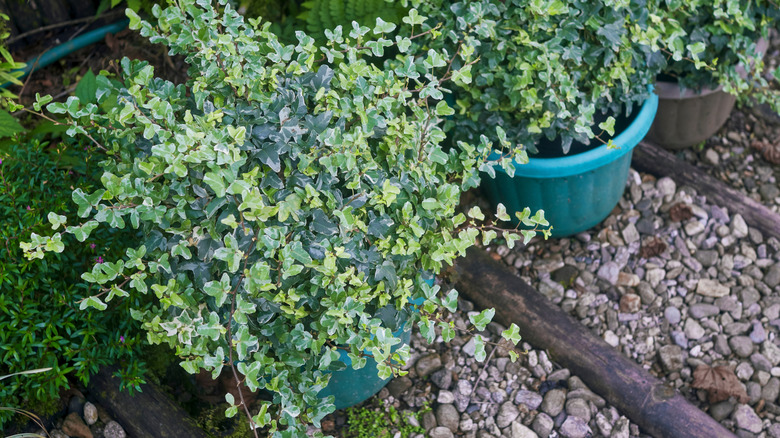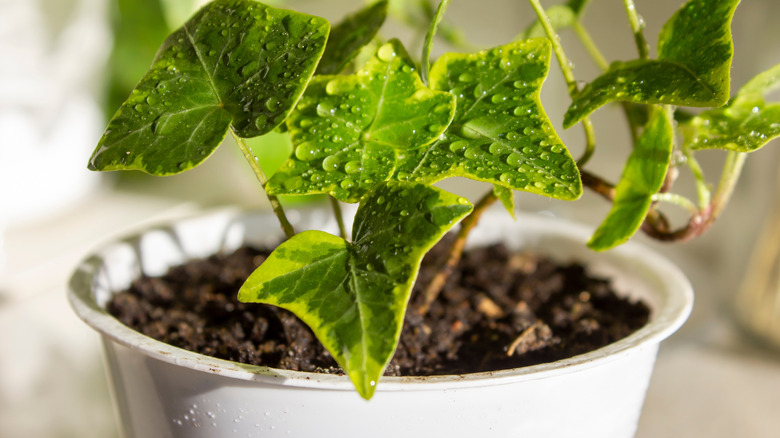The Reason Why Your English Ivy Plant Doesn't Play Nicely With Others
Picture this: It's the start of spring, and you decide to fill your planters with an array of container-friendly plants. It's all happy gardens until a few months into summer, when everything but the English ivy (Hedera helix) you threw into the mix starts to languish. It turns out English ivy is an allelopathic plant, which basically means it releases chemicals into the soil to slow and even halt the growth of its neighbors. In other words, it doesn't play nicely with others.
English ivy looks good, grows fast, and doesn't require much in the way of maintenance, which is probably why so many people favor it despite it being classified as an invasive species and a noxious weed. Beyond its allelopathic tendencies, there's another reason this evergreen climbing vine isn't exactly a team player in the garden. Because of how quickly and completely it takes over, English ivy tends to create what's called a monoculture — an area where it's the only thing left thriving. That's not great for biodiversity, especially if you're trying to grow a variety of flowers, shrubs, or even vegetables. So while it might be lovely to look at, you'll want to think twice before adding it to your outdoor space.
Why English ivy isn't safe — even as an indoor houseplant
English ivy grows fast and thick, crawling over the ground and climbing anything in its path — fences, trees, walls, you name it. Given how aggressively it spreads and how notoriously difficult it is to remove once established, it's no surprise that some common ivy plant varieties are outright banned in Washington and Oregon. So what does that mean for gardeners living elsewhere? If you're drawn to ivy for its classic look and hands-off appeal, the safest option is to keep it strictly as an indoor houseplant. That way, there's no chance of birds eating its berries and spreading seeds into nearby greenbelts or natural areas — a major concern with outdoor planting, even in containers.
Even so, English ivy isn't completely risk-free indoors. It's toxic to dogs, cats, and humans if eaten, making it a poor choice for homes with curious pets or young children unless it can be kept out of reach. And don't forget, it's a toxic roommate: it won't share a pot without causing trouble. Ultimately, English ivy requires more active management than many gardeners expect. If you're not up for the challenge, it may be easier (and more environmentally responsible) to opt for a less-demanding alternative.
Try these English ivy-like alternatives that are way easier to live with
If you're drawn to English ivy for its trailing vines and rich green texture, you're not alone — it's undeniably eye-catching. But if you'd rather avoid the stress of managing an aggressive or invasive plant, there are plenty of beautiful English ivy alternatives that offer a similar look without causing trouble in your garden. One such option is sweet potato vine (Ipomoea batatas), which is equally amenable to life indoors or as ground cover. With its vibrant, heart-shaped foliage and striking color varieties — from rich purples to vivid greens — this lush vine does a fantastic job of adding visual interest to its surroundings.
If you're after a climbing plant, Boston ivy (Parthenocissus tricuspidata) is worth a second look. Although it's not a true ivy (it's actually from the grape family), it adheres well to surfaces and turns a brilliant red in the fall. With its roots in Japan, Boston ivy is technically listed as invasive in some regions. However, when it spreads beyond cultivated areas, it's often outcompeted by more aggressive native vines like Virginia creeper, which helps curb its long-term impact.
Spreading wood fern (Dryopteris expansa) is a deciduous fern with soft, finely divided green fronds that grow in upright clumps from a scaly base. Thriving in part to full shade, it's ideal for shady borders, underplanting, or gardens aiming for a more natural look. It's non-invasive and works well in shaded woodland settings. Ultimately, you can still get the trailing, romantic look of ivy without the constant worry of it taking over your garden, or worse, your entire neighborhood. These alternatives offer beauty, versatility, and far fewer headaches, making them ideal for gardeners who want lush greenery that gets on well with other plants.

